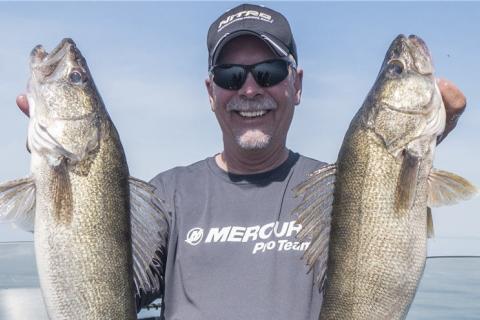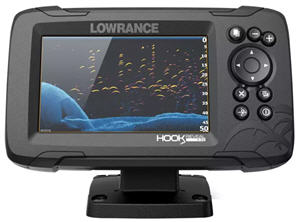
Walleyes in August aren’t always eager to bite, but if you hit them with a one-two punch, chances are you will find success!
During this time of year on many bodies of water, the walleyes are relating to structure. This includes both sunken islands and deeper drop-offs.
Punch #1: Throwing Crankbaits

The first punch that you think of throwing is the trolling crankbaits punch; targeting fish that are relating to, and suspended near these types of structure. Quite often by trolling along the edge, just above rocks, or to the outside, just over the mud basins you will be able to trigger a bite. It is important to keep your baits a few feet off of the structure part of the bottom and follow the edges of the deep rock lines if possible. This isn’t a time to troll around all willy-nilly.... Boat control and accuracy is the key!
When trolling smaller lakes with smaller walleyes, we will use Berkley Flicker Shad crankbaits and Flicker Minnows usually in sizes 5 through 7. You’ll be able to more accurately target proper depths with the “The Precision Trolling App” as this simple to use phone app will tell you how much line to let out to get the lure to the desired depth.

If you need to get the lure deeper than what the natural dive curve of the bait will allow, use Off Shore Tackle weights to get it where it needs to be. Also use Off Shore planer boards to target the suspended fish that lie suspended just to the outside of the structure edge.
If your favorite lake has larger walleyes, like many of the Great Lakes, or for instance, a Lake of the Woods, you should use larger baits. A #9 Flicker Shad is lure that you can use on occasion, but the #9 and #11 Flicker Minnows should be your bread and butter!
 When it comes to speed, troll as fast as you can, but still consistently
When it comes to speed, troll as fast as you can, but still consistently
catch fish. The faster you can troll means the more water you’ll cover throughout the course of the day. If the water temperature is hovering around 70 degrees, try trolling from 2.0 to 2.2 mph. If it is below 70 degrees, slow it down to 1.4 to 1.8 mph. Once it gets above 70, experiment with speeds up to 2.5 mph.
There are a couple of things that really aid catching walleyes during this type of bite. The first is having really good mapping, so you can see where the rock bars and long points are. With marine electronics like the Navionics SonarChart Live you can actually update your maps (if you’re using a Lowrance HDS Live series, or Carbon unit)…in real time! This is an awesome feature, allowing you to map out detail on a piece of structure that you otherwise would not be able to see!
Tip: Shop Lowrance marine electronics at basspro.com

Trolling the edge of structure is where the Lowrance Sonar StructureScan features, with SideScan, really gets a workout. You’ll be able to view structure, game fish, and baitfish off to the side of the boat. When fishing this type of bite use your SideScan to look for the distinct rock to mud or sand edge. Between the mapping and sonar, along with good boat control you’ll always be able to stay on the edge.
Punch #2 Toss a Moonshine Lure Shiver Minnow Bait
There are many times that August fish will stay tight to rocks or drop-offs and this is where your second “punch” comes in. Up until a few years ago, it was thought that the only way to catch walleyes on this deep rock slope and edge was to troll right over their heads. If the fish were active, they would come up to hit the bait. Now when you see fish relating tight to bottom you should go for the reactionary bite by tossing a Moonshine Lure Shiver Minnow at them. This is a really cool way to fish!

When targeting large walleyes, you’ll want to use a size #3 Shiver Minnow, but before you head out fishing, replace the small “ice” treble on the belly of the lure with a Mustad #6 KVD Elite Triple Grip Treble (model TG58BN). This hook gives the bait a bigger “bite” for better hooking and the inward bend of the hook helps keep fish on. For lakes that have smaller walleyes use the size #1 and #2. You will not have to change those hooks as they work well right out of the box.
The line to use on your spinning gear for this presentation is the bright colored 10-12lb. test Berkley Nanofil in Hi-Vis Chartreuse. This will help you to see when the bait makes contact with the bottom. Since this is a no-stretch line, it is sensitive enough to feel everything the lure comes in contact with. Nanofil is also a thin diameter line, so it there isn’t a lot of loop in the line when fishing in the wind. This line also provides for great long distance hook-sets and is strong enough to fight fish that hit hard!

To help cut down on visibility of the line to the fish, reduce lure tangles, and to add some protection from abrasions when running across zebra mussels and rocks, use a 3-foot leader from the main line to the lure of 10lb. test Berkley Trilene 100% Fluorocarbon.
Look for your fish first! This is done by driving around structure elements on the lake while graphing for fish with your sonar units. With Lowrance units, when you mark a fish, or preferably a small group of them, you can scroll back on the sonar and place a waypoint directly on the marked fish. You can now position your boat to cast to those fish using the waypoint as a reference.
When fishing in rough conditions move upwind and anchor, or in calm conditions move to the side and cast to your “located” fish. A highly accurate trolling motor, like the MotorGuide Xi5, plays an important role in this type of fishing. Once positioned, put the motor in “Anchor Mode” to hold the boat in place. If you want to move a few feet in any direction use the “jog” feature to put you where you want to be.
Your rod cadence is extremely important. Start by sweeping the rod up about three feet; almost to the point of snapping it up. Doing this makes the lure dart to the side.
Follow this by immediately dropping the rod tip to give it slack and let the bait glide as you reel in the slack line. The instant the lure hits bottom, repeat this cadence. Most bites will come on the drop while there is slack in the line. Be sure if you feel weight on the line as you go to make the next pull to set the hook hard to bring in your Next Bite!
Editor’s Note: If you have questions or comments on this or other articles of mine you may have read, contact me through the website The NextBite.
- 17787 views

